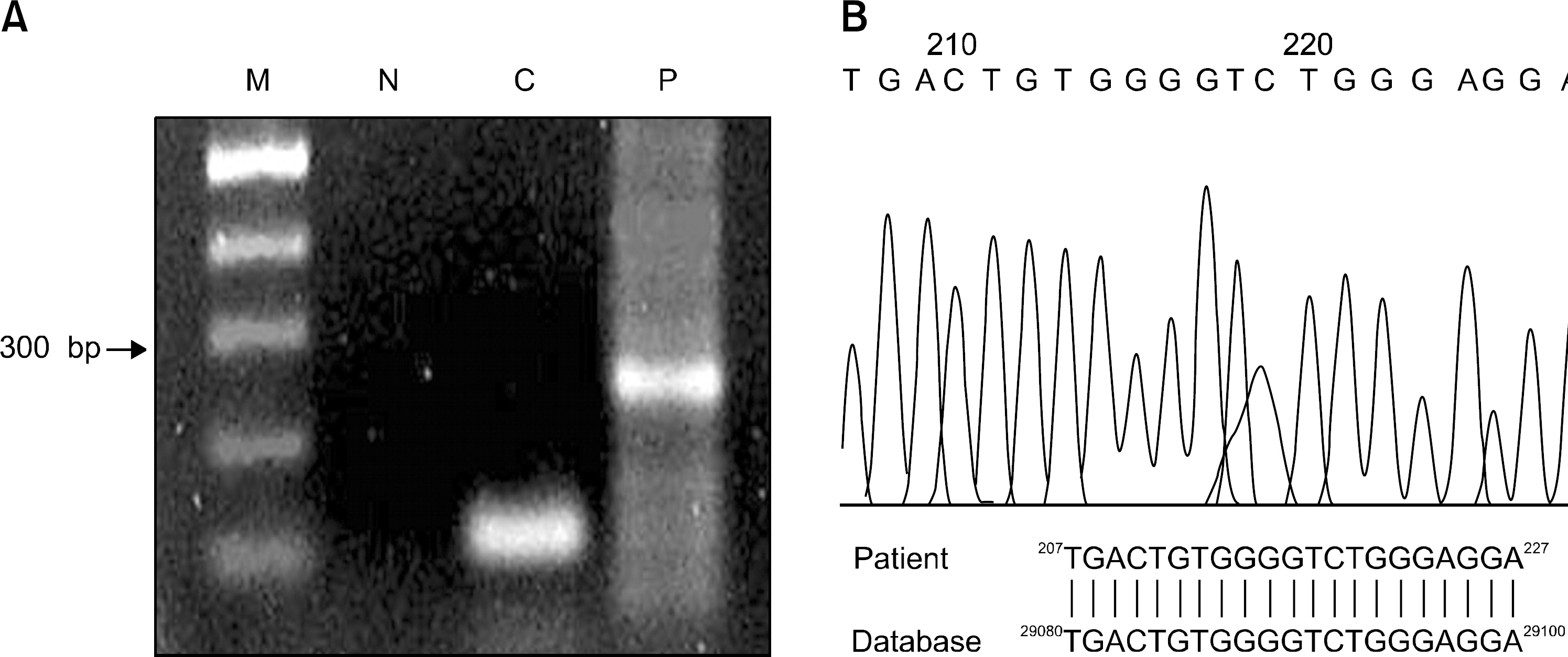Korean J Hematol.
2006 Jun;41(2):129-133. 10.5045/kjh.2006.41.2.129.
CD56+ T-cell Prolymphocytic Leukemia Showing a High Expression Level of TCL1 Oncogene: A Case Report with a Review of the Literature
- Affiliations
-
- 1Department of Laboratory Medicine, Chonnam National University Medical School, Chonnam National University Hwasun Hospital, Korea. mgshin@chonnam.ac.kr
- 2Genome Research Center for Hematopoietic Disease, Chonnam National University Hwasun Hospital, Korea.
- 3Department of Laboratory Medicine, Sunchon St. Carollo Hospital, Hwasun, Korea.
- KMID: 2083489
- DOI: http://doi.org/10.5045/kjh.2006.41.2.129
Abstract
- T-cell prolymphocytic leukemia (T-PLL) is a rare mature post-thymic T-cell malignancy with infiltration to the blood, bone marrow, lymph node, liver, spleen and skin; this disease has a poor prognosis and an aggressive clinical course. We report here on a case of CD56+ T-PLL that was diagnosed by hematological examination, immunophenotyping and molecular studies including determining the TCL1 expression by using reverse-transcriptase polymerase chain reaction (RT-PCR), and direct sequencing of the RT-PCR product.
Keyword
MeSH Terms
Figure
Reference
-
1). Jaffe ES., Harris NL., Stein H., Vardiman JW. Pathology and genetic of tumor of hematopoietic and lymphoid tissues. Kleihues P, Sobin L, editors. World Health Organization classification of tumors. vol 3. Lyon: IARC Press;2001.2). Matutes E., Brito-Babapulle V., Swansbury J, et al. Clinical and laboratory features of 78 cases of T-prolymphocytic leukemia. Blood. 1991. 78:3269–74.
Article3). Matutes E. T-cell prolymphocytic leukemia. Cancer Control. 1998. 5:19–24.
Article4). Catovsky D., Galetto J., Okos A., Galton DA., Wiltshaw E., Stathopoulos G. Prolymphocytic leukaemia of B and T cell type. Lancet. 1973. 2:232–4.5). Kojima K., Kobayashi H., Imoto S, et al. 14q11 abnormality and trisomy 8q are not common in Japanese T-cell prolymphocytic leukemia. Int J Hematol. 1998. 68:291–6.6). Park JE., Kim KM., Kim WY, et al. A Case of Small Cell Variant of T-Cell Prolymphocytic Leukemia. Korean J Hematol. 2005. 40:177–82.
Article7). Herling M., Khoury JD., Washington LT., Duvic M., Keating MJ., Jones D. A systematic approach to diagnosis of mature T-cell leukemias reveals heterogeneity among WHO categories. Blood. 2004. 104:328–35.
Article8). Dearden CE. T-cell prolymphocytic leukemia. Med Oncol. 2006. 23:17–22.
Article9). Virgilio L., Narducci MG., Isobe M, et al. Identification of the TCL1 gene involved in T-cell malignancies. Proc Natl Acad Sci USA. 1994. 91:12530–4.
Article10). Herling M., Teitell MA., Shen RR., Medeiros LJ., Jones D. TCL1 expression in plasmacytoid dendritic cells (DC2s) and the related CD4+ CD56+ blastic tumors of skin. Blood. 2003. 101:5007–9.
Article11). Dearden CE., Matutes E., Cazin B, et al. High remission rate in T-cell prolymphocytic leukemia with CAMPATH-1H. Blood. 2001. 98:1721–6.
Article
- Full Text Links
- Actions
-
Cited
- CITED
-
- Close
- Share
- Similar articles
-
- Small cell variant of T-cell prolymphocytic leukemia with atypical presentation
- A Case of Small Cell Variant of T-Cell Prolymphocytic Leukemia
- A Case of Unspecified Mature T-cell Leukemia with Clover-shaped, Multi-lobated Nuclei
- A Case of B-Prolymphocytic Leukemia and Another Case of B-Chronic Lymphocytic Leukemia/Prolymphocytic Leukemia
- A Case of Chronic Myelogenous Leukemia with Abnormal Expression of N-CAM (CD56) Adhesion Molecule on CD34-negative Non-blastic Myeloid Cells



